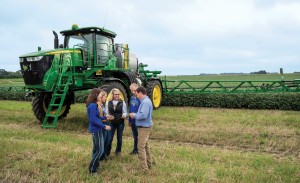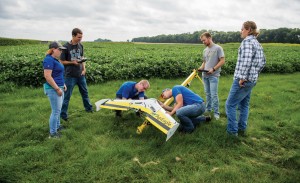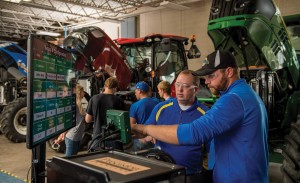TomTom might be the guide to the new restaurant you want to visit and similar global positioning equipment likely guided the production of the food served at the restaurant.

As part of its land-grant mission, State has the nation’s first bachelor’s degree in precision agriculture. Students learn how to use the latest technology and make crop management decisions when it’s their time in the field.
Forms of precision agriculture are increasingly being adopted by America’s farmers. GPS guidance is used in about half of the planting of corn acres, according to the U.S. Department of Agriculture’s Economic Research Service.
Other areas where technology application is growing are soil mapping, yield monitoring and variable-rate input applications (i.e., applying nitrogen based on need rather than blanket rate).
That means industry needs a labor force trained in the latest techniques. Hence, in July 2016 the South Dakota Board of Regents approved SDSU starting the nation’s first bachelor’s degree in precision agriculture. The state’s 1862 land-grant institution had started a precision ag minor two years earlier. Response to that helped convince the administration to expand that to a major.
This fall there are 93 students pursuing a precision ag minor with 54 in the major. The number of majors could double in two years, university officials say. Just one year earlier there were 19 majors.
That huge increase will be fueled by industry demand and the strength of the cooperating departments, said Douglas Prairie, an instructor in agricultural and biosystems engineering.
“Precision ag has gotten a lot of publicity. It’s gone beyond a niche to mainstream. Companies have made significant advances in precision ag hardware and software and want to hire graduates who they don’t have to train in those technologies,†said Prairie, a 1997 ag engineering graduate who joined the faculty in fall 2016 after nearly 20 years of working in the industry.
“Our agronomy program is well-known throughout the country and our AST (ag systems technology) program is well respected. By taking two solid programs and making a hybrid, I see nothing but success coming out of it,†Prairie said.
 David Wright, head of the department of agronomy, horticulture and plant science, agrees.
David Wright, head of the department of agronomy, horticulture and plant science, agrees.
“The future of farm profitability and environmental sustainability is in understanding the data and information collected by precision technology. Numbers are just numbers unless you know how to utilize them to make better crop-management decisions. The new precision ag degree will do just that,†he says.  Â
Ag, engineering colleges combine resources
The program is a cooperative effort of the agronomy, horticulture and plant science department, agricultural and biosystems engineering and mathematics and statistics.
 New classes were created in all three departments to form the precision ag major, according to Van Kelley, head of agricultural and biosystems engineering. Math’s contribution is an upper-level class in geospatial data analysis. Agricultural and biosystems engineering added electrical diagnostics for farm machinery, climate risk management for precision ag, and principles and implications of chemical application systems.
New classes were created in all three departments to form the precision ag major, according to Van Kelley, head of agricultural and biosystems engineering. Math’s contribution is an upper-level class in geospatial data analysis. Agricultural and biosystems engineering added electrical diagnostics for farm machinery, climate risk management for precision ag, and principles and implications of chemical application systems.
Agronomy, horticulture and plant science developed a class on the use of soil and plant science sensors in crop production.
Through internally reallocating staff, each department also gained a full-time faculty member to put SDSU in position to offer the nation’s first precision ag major.
Students learn on Kubota UTVs
The other adaption needed for the major was additional equipment. In summer 2016, the agricultural and biosystems engineering department purchased eight Kubota side-by-side utility terrain vehicles. “We worked closely with Raven Industries to get them outfitted with the latest auto steer. We’ve worked with sprayer companies and have different types of equipment that can be connected to the UTVs,” Kelley said.
“We can have a student understand the same monitoring control experience with only two rows instead of 16,†he said.
Kelley notes that after the major was announced, it made a splash in the trade press, including articles in Farm Journal, Progressive Farmer, PRECISION Ag, Ag Week and Ag Professional. But at some points, first will just be part of a trivia question.
Prairie said the precision ag major “has the potential for going beyond just being first, but being the premier program. When people think of precision ag, they want people to think of SDSU as the premier program. President (Barry) Dunn and the administration is committed to that with a multiyear plan for a new building and equipment.Â
“Engineering students working with AST (ag system technology) students and agronomy students will provide more opportunities for learning.â€
Precision ag to benefit South Dakota economy
The benefits of the program extend far beyond providing job-ready graduates for the labor market.
Aaron Franzen, an assistant professor in agricultural and biosystems engineering, noted, “Agriculture contributes more than $25 billion to the South Dakota economy annually. This represents more than 20 percent of the state’s economic output while employing 115,000 residents, directly or indirectly.Â
“Increases in the adoption of precision agriculture benefits the whole economy of South Dakota. Precision agriculture adoption increases the opportunities for engineering graduates to create new, innovative products for the agricultural market. Graduates with the knowledge and understanding of the agricultural systems will provide both a strong workforce pool and knowledgeable user base for precision ag equipment.â€
Faculty research an untapped field
Beyond that are research possibilities in precision ag that are just starting to be explored by the college’s faculty and students.
Individually, Franzen is working to create a more sophisticated optical sensor for the study of plant growth and development. He is also working with a couple mathematics and statistics department faculty members to gain National Science Foundation funding on the large-scale analysis of data from equipment already in the field.
“Statistically, when you compare the average national yield on university research plots with the average farm yield and multiply that by South Dakota cropland, we’re leaving $1 billion in the field every year. The effort is to close that gap in a sustainable way as well as monitoring soil health and raising protein levels.
“There is a lot of genetic potential in the newest hybrids. Improving management practices and further adopting precision ag approaches will help growers fully tap that potential,†said Franzen.
Wright added, “Hybrid selection is key to increasing farm productivity. However, proper placement at the field scale coupled with being able to vary the planting rate to match field conditions is necessary to tap into the genetic-yield potential. Today’s precision tools can help farmers do that.
“Tomorrow’s precision tools will enable farmers to manage each field more accurately, more quickly and more economically.â€
Dave Graves






